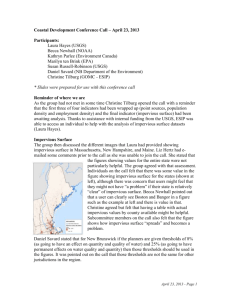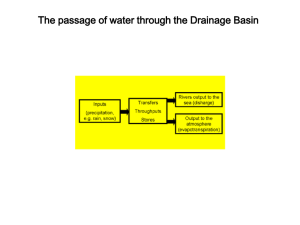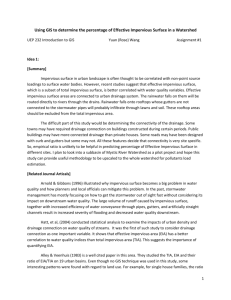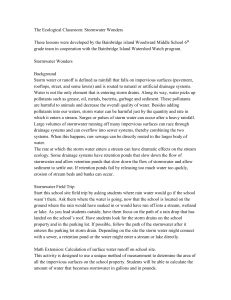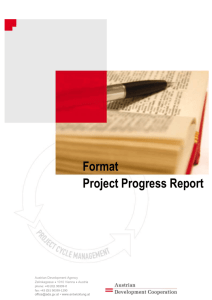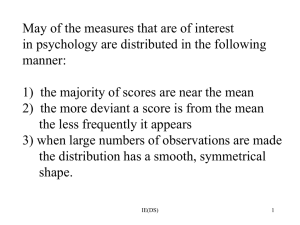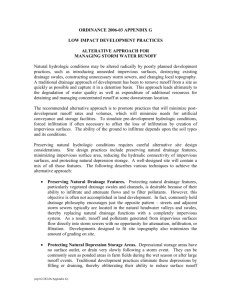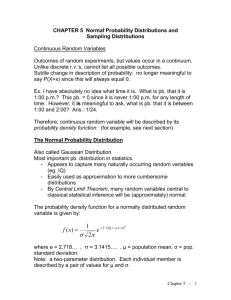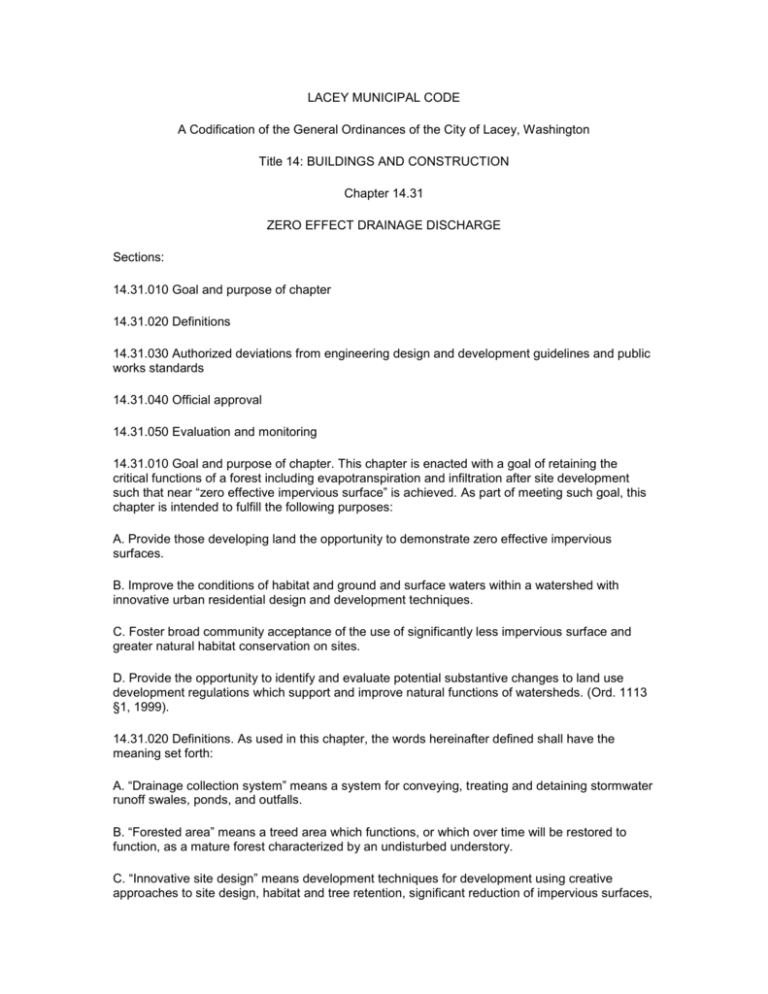
LACEY MUNICIPAL CODE
A Codification of the General Ordinances of the City of Lacey, Washington
Title 14: BUILDINGS AND CONSTRUCTION
Chapter 14.31
ZERO EFFECT DRAINAGE DISCHARGE
Sections:
14.31.010 Goal and purpose of chapter
14.31.020 Definitions
14.31.030 Authorized deviations from engineering design and development guidelines and public
works standards
14.31.040 Official approval
14.31.050 Evaluation and monitoring
14.31.010 Goal and purpose of chapter. This chapter is enacted with a goal of retaining the
critical functions of a forest including evapotranspiration and infiltration after site development
such that near “zero effective impervious surface” is achieved. As part of meeting such goal, this
chapter is intended to fulfill the following purposes:
A. Provide those developing land the opportunity to demonstrate zero effective impervious
surfaces.
B. Improve the conditions of habitat and ground and surface waters within a watershed with
innovative urban residential design and development techniques.
C. Foster broad community acceptance of the use of significantly less impervious surface and
greater natural habitat conservation on sites.
D. Provide the opportunity to identify and evaluate potential substantive changes to land use
development regulations which support and improve natural functions of watersheds. (Ord. 1113
§1, 1999).
14.31.020 Definitions. As used in this chapter, the words hereinafter defined shall have the
meaning set forth:
A. “Drainage collection system” means a system for conveying, treating and detaining stormwater
runoff swales, ponds, and outfalls.
B. “Forested area” means a treed area which functions, or which over time will be restored to
function, as a mature forest characterized by an undisturbed understory.
C. “Innovative site design” means development techniques for development using creative
approaches to site design, habitat and tree retention, significant reduction of impervious surfaces,
changes in traditional site features such as roads and structures in favor of natural habitat
features which result in zero or near-zero drainage discharge from the site after development.
D. “Zero effective impervious surface” means impervious surface reduction to a small fraction of
that resulting from traditional site development techniques such that usual manmade drainage
collection systems are not necessary.
E. “Zero effective impervious surface project” means those projects characterized by a reduction
of total impervious surface to a small fraction of that which would result from traditional
development. Such projects will place impervious surfaces in increments such that run off travel
distance to a vegetative buffer is minimized and does not exceed a maximum of fifteen
feet. Further, the landscaped areas within such projects will be minimized and buffered on the
down-slope side by a forested area. A forested area shall comprise at least 60 per cent of the
land area upon which the project is located, shall be maintained in perpetuity and shall substitute
for a traditional drainage system. It is preferred that the site for such projects be characterized by
a predominance of Soils Conservation Service Class C or D soils. (Ord. 1113 §1, 1999).
14.31.030 Authorized deviations from engineering design and development guidelines and public
works standards. In order to accomplish the purposes and goal of Chapter 14.31, the site plan
review committee may approve or for those projects requiring review and approval by either the
hearings examiner or by the city council, recommend approval of deviations from engineering
design and the provisions of Lacey’s Development Guidelines and Public Works Standards in
accordance with the requirements set forth in Chapter.14.31 Deviations shall be based on the
following criteria:
A. The deviations contribute to and are consistent with the zero effective impervious surface
goals of this chapter.
B. The proposed development project offers reasonable assurance that near zero effect
impervious surface will be achieved and maintained.
C. The deviations do not threaten public health or safety.
D. The deviations are consistent with generally accepted engineering and design criteria, except
as necessary to achieve the purposes set forth in Chapter 14.31.
E. The deviations promote one or more of the following:
1. Innovative site or housing design furthering the purposes of the program;
2. Increased on-site stormwater retention using a variety of native vegetation;
3. Retention of at least 60 per cent of natural habitat conditions over the site;
4. Improved on-site water quality beyond that required by current applicable regulations;
5. Retention or re-creation of pre-development and/or natural hydrologic conditions to the
maximum extent possible;
6. The reduction of effective impervious surfaces to near zero.
F. The deviations do not allow density greater than what would otherwise be allowed under city
regulations then in effect.
The applicant will be required to list and document the justification for each deviation
requested. In order for such a project to be approved, it must be demonstrated that the project
meets all other requirements of the Lacey Municipal Code except for such specific deviations and
that such project has a reasonable assurance of long term success. There shall be submitted in
conjunction with each such project, covenants, conditions and restrictions which will be binding
upon the property and which require forest retention, no net increases in impervious surface and
such other critical features as the city may require. (Ord. 1113 §1, 1999).
14.31.040 Official approval. All projects proposed under the terms of Chapter 14.31 shall require
approval of either a plat or an official site plan approved pursuant to the provisions of this code in
recordable form which shall be binding upon the owners of the real property, their heirs and
assigns. Such plat or official site plan shall include a specific land clearing and tree retention plan,
which shall be referenced upon the face of the plat, or binding site plan. All development of the
land, site design, landscaping, natural drainage features, habitat protection, stormwater design
and the design, placement and size of housing or other buildings and any additional site features
shall be consistent with the approved plat or site plan. Any changes will require a formal
application and amendment of either the plat or the official adopted site plan pursuant to the
provisions of the Lacey Municipal Code. (Ord. 1113 §1, 1999).
14.31.050 Evaluation and monitoring. Each application for approval of a project pursuant to the
terms of Chapter 14.31 shall be accompanied by a proposed monitoring and evaluation process
designed to measure the performance of specific elements addressed in the deviations sought for
the project. After the approval of a project, the city shall, with such cooperation as may be
required of the property owner, document project progress, and in particular, those innovations
and code deviations granted as part of such project approval. Written progress evaluations shall
be prepared by the staff of the Public Works Department and provided to the Site Plan Review
Committee and City Council. An annual report on all such approved projects shall be prepared for
the City Council including a summary description and evaluation of each selected project and any
recommendations regarding substantive changes to the Lacey Municipal Code which are
supported by such evaluation. (Ord. 1113, §1, 1999).
© Copyright 2000
City of Lacey, Washington, USA
All Rights Reserved


